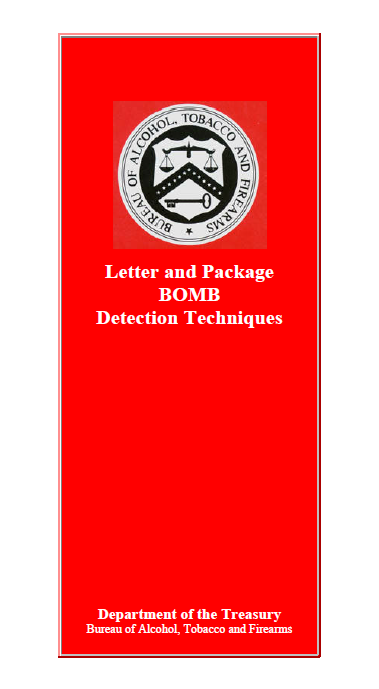 ATF P 3320.5 (8/96)
ATF P 3320.5 (8/96)
- 6 pages
- August 1996
Detecting Suspiscious [sic] Packages / Letters
*REMEMBER*
The item does not have to be
delivered by a carrier. Most
bombers set up and deliver the
bomb themselves.1. If delivered by carrier, inspect for
lumps, bulges, or protrusions,
without applying pressure.2. If delivered by carrier, balance
check if lopsided or heavy sided.3. Handwritten addresses or labels
from companies are improper.
Check to see if the company exists
and if they sent a package or letter.4. Packages wrapped in string are
automatically suspicious, as modern
packaging materials have eliminated
the need for twine or string.5. Excess postage on small packages or
letters indicates that the object was
not weighed by the Post Office.6. No postage or non-canceled postage.
7. Any foreign writing, addresses, or
postage.8. Handwritten notes, such as: “To Be
Opened in the Privacy of”
“CONFIDENTIAL” – “Your Lucky Day
is Here” – “Prize Enclosed”.9. Improper spelling of common names,
places, or titles.10. Generic or incorrect titles.
11. Leaks, stains, or protruding wires,
string, tape, etc.12. Hand delivered or dropped off for a
friend packages or letters.13. No return address or nonsensical return
address.14. Any letters or packages arriving before
or after a phone call from an unknown
person asking if the item was received.15. If you have a suspicious letter or
package,Call:
911-ISOLATE-EVACUATEBombs
Bombs can be constructed to look
like almost anything and can be
placed or delivered in any number of
ways. The probability of finding a
bomb that looks like the
stereotypical bomb is almost
nonexistent. The only common
denominator that exists among
bombs is that they are designed or
intended to explode.Most bombs are homemade and are
limited in their design only by the
imagination of, and resources
available to, the bomber. Remember,
when searching for a bomb, suspect
anything that looks unusual. Let the
trained bomb technician determine
what is or is not a bomb.
